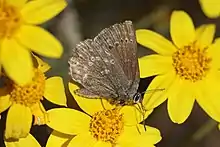Satyrium semiluna
Satyrium semiluna, known generally as the sagebrush sooty hairstreak or half-moon hairstreak, is a species of hairstreak in the butterfly family Lycaenidae. It is found in North America.[1][2][3][4] The MONA or Hodges number for Satyrium semiluna is 4277.1.[5]
| Satyrium semiluna | |
|---|---|
 | |
| Satyrium semiluna (female) | |
| Scientific classification | |
| Kingdom: | Animalia |
| Phylum: | Arthropoda |
| Class: | Insecta |
| Order: | Lepidoptera |
| Family: | Lycaenidae |
| Genus: | Satyrium |
| Species: | S. semiluna |
| Binomial name | |
| Satyrium semiluna Klots, 1930 | |
Formerly included in Satyrium fuliginosa, it is similar to the Icaricia icarioides female. The latter species has range, flight-times and host plant overlaps. Unlike the Icaricia icarioides female, Satyrium semiluna lacks blue scales above, white fringe on the wings, and dark cell-end bar on the forward wing. Not present are the one to three basal black dots on the ventral hind wing that the Icaricia icarioides female usually has.[4]
The range of Satyrium semiluna is similar to that Satyrium behrii but does not extend as far south. Satyrium semiluna larvae feed on lupines, e.g., Lupinus sericeus and Lupinus lepidus.[4]
Subspecies
These two subspecies belong to the species Satyrium semiluna:
- Satyrium semiluna maculadistinctum Mattoon & Austin in T. Emmel, 1998
- Satyrium semiluna semiluna Klots, 1930
References
- "Satyrium semiluna Report". Integrated Taxonomic Information System. Retrieved 2019-09-24.
- "Satyrium semiluna". GBIF. Retrieved 2019-09-24.
- "Satyrium semiluna species Information". BugGuide.net. Retrieved 2019-09-24.
- Pyle, Robert Michael; LaBar, Caitlin C. (2018). Butterflies of the Pacific Northwest. Portland, Oregon: Timber Press. p. 197. ISBN 978-1604696936.
See [Satyrium fuliginosa], in which this one was formerly included ... its habitat, host plant lupines, and flight period largely overlap with those of the Boisduval's Blue, so its likeness to that butterfly is all the more striking. Even still, the butterfly does have its own look. Perch awhile by a patch of woolly sunflowers with both species nectaring, and you will soon detect the distinctive traits of each. The Halfmoon can look much like a female Boisduval's Blue that has been rubbed below, and they both frequent lupines, but practice will give you the eye for it. Less ubiquitous than that blue and not often as numerous, the subtly lovely Halfmooon Hairstreak is always a special find.
- "North American Moth Photographers Group, Satyrium semiluna". Retrieved 2019-09-24.
Further reading
- Pohl, Greg; Patterson, Bob; Pelham, Jonathan (2016). Annotated taxonomic checklist of the Lepidoptera of North America, North of Mexico (Report). doi:10.13140/RG.2.1.2186.3287.